Harald Hardrada
- King of Norway 1046-1066
Harald Hardrada (Harald III Sigurdsson) is often known as "the last real Viking," and maybe he was what many understood by a real Viking king. He was born in 1015, son to the chieftain Sigurd Syr, and with war in the blood from when he as a 15-year old participatede in the Battle of Stiklestad till he died during the Norwegian invasion of England in 1066.
Harald distinguished himself in the Battle of Stiklestad, a battle between the Danish king Cnut the Great and Haralds half-brother, the later Norwegian king-saint Olav II Haraldsson (Saint Olaf). Being on the losing side, however, Harald had to flee. First he went to Kiev, where he found protection with Prince Jaroslav, a descendant of some of the Vikings who settled there. Then Harald moved on to Constantinople, where he fought in the so-called Varangian Guard. This was an elite unit in the Byzantine army, consisting of Vikings, Englishmen and Normans. As a commander in the Byzantine army, Harald fought in places as far apart as the Mediterranean, Asia Minor, Sicily, the Holy Land and in Constantinople proper.
Rich in combat experience and wealth he returned to Scandinavia n 1046 where he was quick to play his part in the local entanglements. Here, the Norwegian-Danish king Magnus the Good (Magnus I of Norway) fought the Danish pretender Svein Estridsson. Initially, Harald and Svein joined forces, but when Magnus offered Harald co-kingship, he betrayed Svein.
Shortly afterwards, in 1047, Magnus died. Possibly from the injuries he received when pursuing Svein after a battle on Zealand, where he according to legend fell of his horse. Magnus willed Harald to have Norway and Svein Denmark.
Harald was not content with this, however, and in the following years he and Svein often crossed swords - both on land and at sea. Harald plundered and burned Haithabu in 1049 for example, as well as plundering and ravaging many other Danish places during the years. The Skuldelev-blockade of Roskilde Fjord, whose first phase is dated to about 1060, is often interpreted as an attempt to secure Roskilde from Haralds surprise attacks after the disaster in Haithabu. Even though much of Haralds ravaging of Denmark seems pointless today, he probably was too much of a strategist to take on casual raids. Maybe his purpose was to show the Danes how Svein was unable to protect his coasts, thereby depriving him of the Danes' support.
Despite the fact that Svein Estridsson lost almost every battle against Harald, he held on to power. In 1062, or shortly afterwards, a compromise was reached. The warrior king Harald must have realized, that he should seek out new hunting grounds, and following the death of Edward the Confessor in the beginning of 1066, Harald invaded England. At fall the same year he fell in the Battle of Stamford Bridge against England's new king, Harold Godwinson.
Kristian Helmersen
Exercises
Literature
DeVries: The Norwegian invasion of England in 1066. 2003
In Danish
Johannessen: Politikens bog om Danmarks vikingetid. 2001

